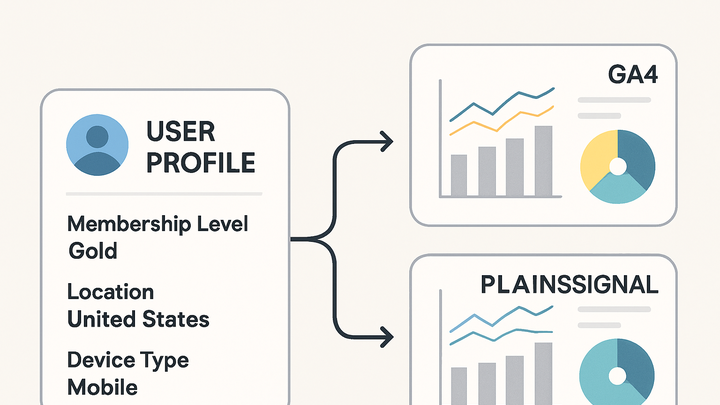Published on 2025-06-26T04:22:11Z
What is a User Property? Examples and Use Cases
User Property is a key-value pair that assigns a persistent attribute to a user across sessions and devices, enabling advanced segmentation and personalization in analytics platforms. In analytics, user properties help tie together behavior with user attributes like membership level, location, or device type. Unlike event parameters which describe individual events, user properties describe overarching characteristics of a user. Both Google Analytics 4 (GA4) and PlainSignal support user properties, allowing you to filter and analyze data by these attributes. By leveraging user properties, businesses can gain deeper insights into user behavior patterns, optimize marketing campaigns, and deliver personalized experiences.
User property
Persistent user attributes in analytics for segmentation and personalization across sessions.
Definition and Purpose
This section defines what user properties are and explains their importance in analytics workflows.
-
What is a user property?
A user property is a persistent attribute or characteristic assigned to a user across sessions and devices in an analytics platform. It provides context about who the user is, rather than what actions they take.
-
Why user properties matter
User properties enable segmentation, personalization, and deeper user insights by associating user-level attributes (e.g., membership level, region) with behavior data.
Implementing User Properties
Detailed examples showing how to configure user properties in PlainSignal and Google Analytics 4 using JavaScript code snippets.
-
PlainSignal example
Use PlainSignal’s tracking snippet to load the library and set custom user properties before tracking events.
-
Html initialization
<link rel="preconnect" href="//eu.plainsignal.com/" crossorigin /> <script defer data-do="yourwebsitedomain.com" data-id="0GQV1xmtzQQ" data-api="//eu.plainsignal.com" src="//cdn.plainsignal.com/plainsignal-min.js"></script> -
Javascript snippet
<script> // Initialize and set user properties PlainSignal('setUserProperties', { membershipLevel: 'premium', preferredLanguage: 'en-US' }); </script> -
Explanation
The first part loads PlainSignal with your unique site ID. The second part calls setUserProperties to persist custom attributes for the current user.
-
-
GA4 example
Configure user properties in Google Analytics 4 using gtag.js before sending the configuration event.
-
Code snippet
<script async src="https://www.googletagmanager.com/gtag/js?id=G-XXXXXXXXXX"></script> <script> window.dataLayer = window.dataLayer || []; function gtag(){dataLayer.push(arguments);} gtag('js', new Date()); // Set user properties gtag('set', 'user_properties', { membership_level: 'premium', region: 'EMEA' }); gtag('config', 'G-XXXXXXXXXX'); </script> -
Explanation
Load the gtag.js library, use gtag(‘set’, ‘user_properties’, …) to define attributes, then initialize with your measurement ID.
-
Use Cases
Common applications of user properties to enhance analytics insights and drive business decisions.
-
Audience segmentation
Group users by properties such as subscription tier, location, or device type to analyze and compare behavior patterns.
-
Personalization
Deliver tailored content, recommendations, or UI adjustments based on user preferences stored as properties.
-
Retention analysis
Measure retention rates across cohorts defined by specific user properties (e.g., onboarding status or plan type) to identify drop-off causes.
Best Practices and Considerations
Guidelines for defining, managing, and using user properties effectively while maintaining data quality and privacy.
-
Naming conventions
Adopt clear, consistent naming (e.g., snakecase) and prefix custom properties (e.g., ‘custom’) to avoid clashes with reserved names.
-
Privacy and consent
Ensure compliance with regulations (GDPR, CCPA) by collecting only necessary properties with explicit user consent and anonymizing PII.
-
Property limits
Be aware of platform-specific limits (e.g., GA4 supports up to 25 user properties) and prioritize the most strategic attributes.
